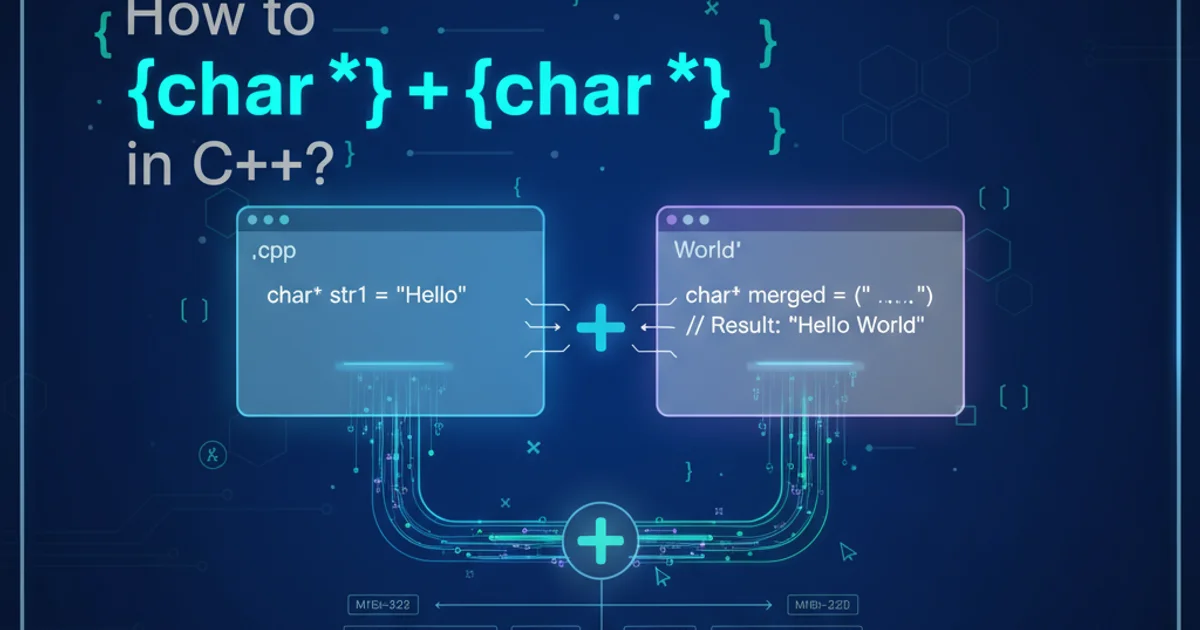How to * char + * char in c++?
Categories:
Mastering Character String Concatenation in C++

Explore various methods for concatenating character arrays (C-style strings) in C++, from basic pointer manipulation to safer, more modern approaches.
Concatenating character arrays, often referred to as C-style strings, is a fundamental operation in C++ programming. Unlike std::string objects which handle memory management and concatenation seamlessly with the + operator, raw char* or char[] types require more careful handling. This article delves into the different techniques for merging character arrays, highlighting their advantages, disadvantages, and best practices.
Understanding C-Style Strings and Memory
Before diving into concatenation, it's crucial to understand what a C-style string is. In C++, a C-style string is a null-terminated sequence of characters stored in a char array. The null character \0 signifies the end of the string. When concatenating, you're essentially copying characters from one array to another, ensuring there's enough allocated memory and that the result is also null-terminated.
flowchart TD
A[Source String 1] --> B{Copy to Destination}
B --> C[Destination String (Part 1)]
C --> D[Source String 2]
D --> E{Append to Destination}
E --> F[Destination String (Full)]
F --> G[Ensure Null Termination]
G --> H[Concatenated String]Conceptual flow of C-style string concatenation
Method 1: Using strcat and strcpy (C-style Functions)
The C standard library provides strcpy for copying strings and strcat for concatenating them. These functions are straightforward but come with significant risks if not used carefully, primarily buffer overflows. You must ensure the destination buffer is large enough to hold the combined length of both source strings plus the null terminator.
#include <iostream>
#include <cstring> // For strcpy and strcat
int main() {
char str1[50] = "Hello, ";
char str2[] = "World!";
// Calculate required size (length of str1 + length of str2 + 1 for null terminator)
// Note: strlen(str1) does not count the existing null terminator, but strcat will overwrite it.
// The 50 for str1 is just an example, actual size should be calculated dynamically if needed.
strcat(str1, str2); // Concatenates str2 to str1
std::cout << "Concatenated string: " << str1 << std::endl;
return 0;
}
Example of strcat for string concatenation
strcat and strcpy is highly discouraged in modern C++ due to their inherent unsafety. They do not perform bounds checking, making them prone to buffer overflows if the destination buffer is not large enough. This can lead to security vulnerabilities and crashes.Method 2: Safer Alternatives - strncat and Manual Copying
To mitigate the risks of strcat, strncat offers a safer alternative by allowing you to specify the maximum number of characters to append. While better, it still requires careful calculation of buffer sizes. A more robust C-style approach involves manually calculating lengths and copying characters, or using snprintf.
#include <iostream>
#include <cstring> // For strlen and strncat
#include <cstdio> // For snprintf
int main() {
char str1[50] = "Hello, ";
char str2[] = "Safe World!";
char result_buffer[100]; // Ensure ample space
// Using strncat (still requires careful size management)
strcpy(result_buffer, str1); // Copy first string
strncat(result_buffer, str2, sizeof(result_buffer) - strlen(result_buffer) - 1); // Append safely
std::cout << "strncat result: " << result_buffer << std::endl;
// Using snprintf (more robust for formatting and concatenation)
char snprintf_buffer[100];
snprintf(snprintf_buffer, sizeof(snprintf_buffer), "%s%s", str1, str2);
std::cout << "snprintf result: " << snprintf_buffer << std::endl;
return 0;
}
Safer C-style concatenation with strncat and snprintf
Method 3: The C++ Way - Using std::string
The most recommended and idiomatic way to handle strings in modern C++ is by using std::string. It automatically manages memory, handles concatenation safely, and provides a rich set of member functions. You can easily convert C-style strings to std::string objects and then use the + operator or append() method for concatenation.
#include <iostream>
#include <string> // For std::string
int main() {
const char* c_str1 = "Hello, ";
const char* c_str2 = "C++ World!";
// Convert C-style strings to std::string and concatenate
std::string s1 = c_str1;
std::string s2 = c_str2;
std::string result_str = s1 + s2; // Using the + operator
// Or: s1.append(s2);
// Or: std::string result_str = std::string(c_str1) + std::string(c_str2);
std::cout << "std::string result: " << result_str << std::endl;
// If you need a C-style string back:
const char* final_c_str = result_str.c_str();
std::cout << "Back to C-style: " << final_c_str << std::endl;
return 0;
}
Concatenating C-style strings using std::string
std::string for string manipulation in C++. It simplifies memory management, prevents common errors like buffer overflows, and integrates well with other C++ features. Only use C-style string functions when absolutely necessary (e.g., interfacing with C APIs).Conclusion and Best Practices
While C-style string concatenation is possible using functions like strcat and strncat, these methods are error-prone and generally not recommended for new C++ code. The std::string class provides a robust, safe, and convenient way to handle string operations, including concatenation. When dealing with legacy code or C APIs that require char*, exercise extreme caution and ensure proper buffer management to prevent vulnerabilities.